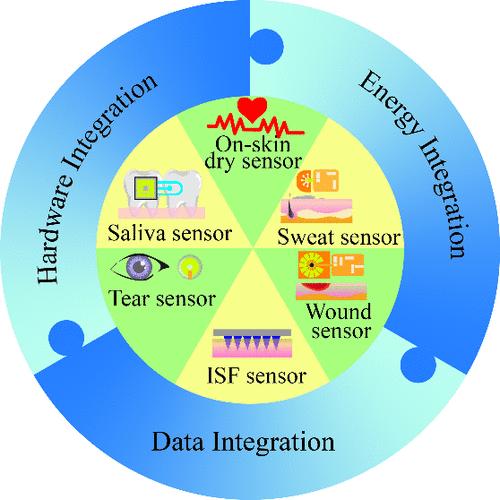当前位置:
X-MOL 学术
›
Chem. Rev.
›
论文详情
Our official English website, www.x-mol.net, welcomes your
feedback! (Note: you will need to create a separate account there.)
Hybrid Integration of Wearable Devices for Physiological Monitoring
Chemical Reviews ( IF 51.4 ) Pub Date : 2024-08-27 , DOI: 10.1021/acs.chemrev.3c00471 Yu Zhang 1 , Xin Ting Zheng 2 , Xiangyu Zhang 1 , Jieming Pan 1 , Aaron Voon-Yew Thean 1
Chemical Reviews ( IF 51.4 ) Pub Date : 2024-08-27 , DOI: 10.1021/acs.chemrev.3c00471 Yu Zhang 1 , Xin Ting Zheng 2 , Xiangyu Zhang 1 , Jieming Pan 1 , Aaron Voon-Yew Thean 1
Affiliation

|
Wearable devices can provide timely, user-friendly, non- or minimally invasive, and continuous monitoring of human health. Recently, multidisciplinary scientific communities have made significant progress regarding fully integrated wearable devices such as sweat wearable sensors, saliva sensors, and wound sensors. However, the translation of these wearables into markets has been slow due to several reasons associated with the poor system-level performance of integrated wearables. The wearability consideration for wearable devices compromises many properties of the wearables. Besides, the limited power capacity of wearables hinders continuous monitoring for extended duration. Furthermore, peak-power operations for intensive computations can quickly create thermal issues in the compact form factor that interfere with wearability and sensor operations. Moreover, wearable devices are constantly subjected to environmental, mechanical, chemical, and electrical interferences and variables that can invalidate the collected data. This generates the need for sophisticated data analytics to contextually identify, include, and exclude data points per multisensor fusion to enable accurate data interpretation. This review synthesizes the challenges surrounding the wearable device integration from three aspects in terms of hardware, energy, and data, focuses on a discussion about hybrid integration of wearable devices, and seeks to provide comprehensive guidance for designing fully functional and stable wearable devices.
中文翻译:

用于生理监测的可穿戴设备的混合集成
可穿戴设备可以提供及时、用户友好、无创或微创、持续的人类健康监测。最近,多学科科学界在汗水可穿戴传感器、唾液传感器和伤口传感器等完全集成的可穿戴设备方面取得了重大进展。然而,由于与集成可穿戴设备的系统级性能较差相关的多种原因,这些可穿戴设备向市场的转化进展缓慢。可穿戴设备的可穿戴性考虑因素会影响可穿戴设备的许多特性。此外,可穿戴设备的有限功率容量阻碍了长时间的连续监测。此外,密集计算的峰值功率操作可能会在紧凑的外形尺寸中快速产生热问题,从而影响耐磨性和传感器操作。此外,可穿戴设备经常受到环境、机械、化学和电气干扰和变量的影响,这些干扰和变量可能会使收集到的数据失效。这就需要复杂的数据分析来根据上下文识别、包含和排除每个多传感器融合的数据点,以实现准确的数据解释。本文从硬件、能源和数据三个方面综合了可穿戴设备集成所面临的挑战,重点讨论了可穿戴设备的混合集成,旨在为设计功能齐全且稳定的可穿戴设备提供全面的指导。
更新日期:2024-08-27
中文翻译:

用于生理监测的可穿戴设备的混合集成
可穿戴设备可以提供及时、用户友好、无创或微创、持续的人类健康监测。最近,多学科科学界在汗水可穿戴传感器、唾液传感器和伤口传感器等完全集成的可穿戴设备方面取得了重大进展。然而,由于与集成可穿戴设备的系统级性能较差相关的多种原因,这些可穿戴设备向市场的转化进展缓慢。可穿戴设备的可穿戴性考虑因素会影响可穿戴设备的许多特性。此外,可穿戴设备的有限功率容量阻碍了长时间的连续监测。此外,密集计算的峰值功率操作可能会在紧凑的外形尺寸中快速产生热问题,从而影响耐磨性和传感器操作。此外,可穿戴设备经常受到环境、机械、化学和电气干扰和变量的影响,这些干扰和变量可能会使收集到的数据失效。这就需要复杂的数据分析来根据上下文识别、包含和排除每个多传感器融合的数据点,以实现准确的数据解释。本文从硬件、能源和数据三个方面综合了可穿戴设备集成所面临的挑战,重点讨论了可穿戴设备的混合集成,旨在为设计功能齐全且稳定的可穿戴设备提供全面的指导。


















































 京公网安备 11010802027423号
京公网安备 11010802027423号